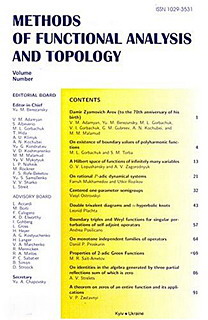Vol. 15 (2009), no. 3
Conservative discrete time-invariant systems and block operator CMV matrices
MFAT 15 (2009), no. 3, 201-236
201-236
It is well known that an operator-valued function $\Theta$ from the Schur class ${\bf S}(\mathfrak M,\mathfrak N)$, where $\mathfrak M$ and $\mathfrak N$ are separable Hilbert spaces, can be realized as a transfer function of a simple conservative discrete time-invariant linear system. The known realizations involve the function $\Theta$ itself, the Hardy spaces or the reproducing kernel Hilbert spaces. On the other hand, as in the classical scalar case, the Schur class operator-valued function is uniquely determined by its so-called "Schur para-me ers". In this paper we construct simple conservative realizations using the Schur parameters only. It turns out that the unitary operators corresponding to the systems take the form of five diagonal block operator matrices, which are analogs of Cantero--Moral--Vel\'azquez (CMV) matrices appeared recently in the theory of scalar orthogonal polynomials on the unit circle. We obtain new models given by truncated block operator CMV matrices for an arbitrary completely non-unitary contraction. It is shown that the minimal unitary dilations of a contraction in a Hilbert space and the minimal Naimark dilations of a semi-spectral operator measure on the unit circle can also be expressed by means of block operator CMV matrices.
A haracterization of closure of the set of compactly supported functions in Dirichlet generalized integral metric and its applications
MFAT 15 (2009), no. 3, 237-250
237-250
We obtain conditions under which a function $u(x)$ with finite Dirichlet ge e alized integral over a domain $G$ ($u(x)\in H(G))$ belongs to the closure of the set $C_0^\infty(G)$ in the metrics of this Dirichlet integral (i.e., to the space $H_0(G)$). In the case where $G=R^n \;(n \geq 2)$ using these conditions we construct examples of Dirichlet integrals such that $H(R^n) \neq H_0(R^n)$. For $n=2$ these examples show that in the known Mazia theorem uniform positivity of the Dirichlet integral matrix cannot be replaced with its pointwise positivity. The characterization of the space $H_0(G)$ is also applied to the problem of relative equivalence of the spaces $H(G)$ and $H_0(G)$ concerning the part of the boundary $\Gamma (\Gamma\subseteq \partial G)$. This problem in fact coincides with the problem of possibility to set boundary conditions of corresponding boundary-value problems.
Morse functions and flows on nonorientable surfaces
MFAT 15 (2009), no. 3, 251-258
251-258
The present paper deals with the correspondence between Morse functions and flows on nonorientable surfaces. It is proved that for every Morse flow with an indexing of saddle points on a nonorientable surface there is a unique Morse function, up to a fiber equivalence, such that its gradient flow is trajectory equivalent to the initial flow, and the values of the function in the saddle points are ordered according to the indexing. The algorithm for constructing the Morse function from a Morse flow with an indexing is given. Reeb graphs and 3-graphs, which assign Morse functions and the corresponding Morse flows with the number of the saddle points less than $3$ are presented.
Some properties for Beurling algebras
MFAT 15 (2009), no. 3, 259-263
259-263
Let $G$ be a locally compact group and let $\omega$ be a weight function on $G$. In this paper, among other things, we show that the Beurling algebra $L^1(G,\omega)$ is super-amenable if and only if $G$ is finite and it is biprojective if and only if $G$ is compact.
Connected components of partition preserving diffeomorphisms
MFAT 15 (2009), no. 3, 264-279
264-279
Let $f:\mathbb{R}^2\to\mathbb{R}$ be a homogeneous polynomial and $\mathcal{S}(f)$ be the group of diffeomorphisms $h$ of $\mathbb{R}^2$ preserving $f$, i.e. $f \circ h =f$. Denote by $\mathcal{S}_{\mathrm{id}}(f)^{r}$, $(0\leq r \leq \infty)$, the identity component of $\mathcal{S}(f)$ with respect to the weak Whitney $C^{r}_{W}$-topology. We prove that $\mathcal{S}_{\mathrm{id}}(f)^{\infty} = \cdots = \mathcal{S}_{\mathrm{id}}(f)^{1}$ for all $f$ and that $\mathcal{S}_{\mathrm{id}}(f)^{1} ot= \mathcal{S}_{\mathrm{id}}(f)^{0}$ if and only if $f$ is a product of at least two distinct irreducible over $\mathbb{R}$ quadratic forms.
Boundary triplets and Titchmarsh-Weyl functions of differential operators with arbitrary deficiency indices
MFAT 15 (2009), no. 3, 280-300
280-300
Let $l [y]$ be a formally selfadjoint differential expression of an even order on the interval $[0,b \rangle$, $b\leq \infty$, with operator coefficients, acting in a separable Hilbert space $H$. We introduce the concept of deficiency indices $n_{b\pm}$ of the expression $l$ at the point $b$ and show that in the case $\dim H=\infty$ any values of $n_{b\pm}$ are possible. Moreover the decomposing selfadjoint boundary conditions exist if and only if $n_{b+}=n_{b-}$. Our considerations of differential operators with arbitrary (possibly unequal) deficiency indices are based on the concept of a decomposing $D$-boundary triplet. Such an approach enables to describe extensions of the minimal operator directly in terms of operator boundary conditions at the ends of the interval $[0,b \rangle$. In particular we describe in a compact form selfadjoint decomposing boundary conditions.
Associated to a $D$-triplet is an $m$-function, which can be regarded as a gene
alization of the classical characteristic (Titchmarsh-Weyl) function. Our definition enables to describe all $m$-functions (and, therefore, all spectral functions) directly in terms of boundary conditions at the right end $b$.


